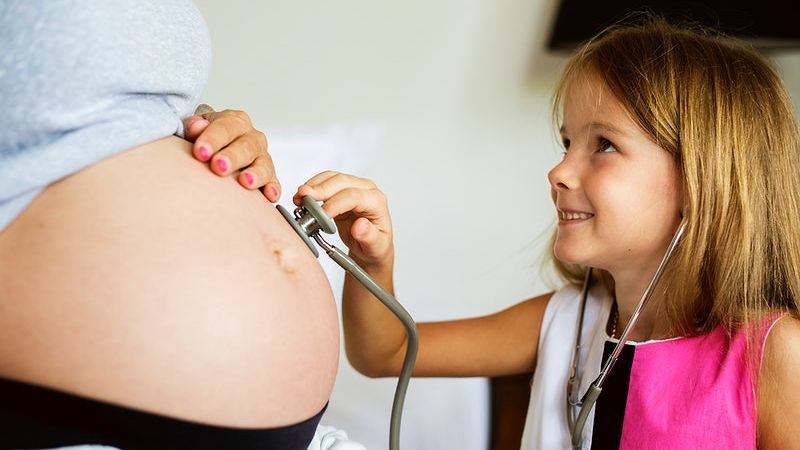Symptoms Introduction

Women may experience, on average, two dozen different symptoms throughout pregnancy based on the physical changes necessary for fetal growth and development as well as labor and delivery. While most of these may be easy to tolerate, others may require help from a health care provider (HCP).
Women experience many symptoms as a direct result of pregnancy; others may be an indirect result of other pregnancy-related symptoms (i.e. constipation leads to hemorrhoids), or certain symptoms could indicate a specific condition that could be related or unrelated to pregnancy.
Women react differently to hormones; therefore, women experience different symptoms during pregnancy that also widely range in severity. This is why some women can have a "glowing" pregnancy while others have a much more difficult time. This is also dependent on a woman's tolerance for certain symptoms as well as her specific "combination" of symptoms at any given time.
Most symptoms disappear instantly upon removal of the placenta, while others go away within a few weeks due to the reduction in hormones. This is in contrast to "signs" of pregnancy, some of which may be permanent (read Body Changes).
It is often recommended that women talk to their HCP at each prenatal appointment about all symptoms they are experiencing, even ones that are tolerable. This can help HCPs determine early what may be normal and related to pregnancy, and what symptoms may be a sign of something else requiring further assessment or monitoring.
Women should continue reading below to better understand a "bird's eye" view about the symptoms they are experiencing, why they are experiencing them, how best to manage them, and when to call their HCP. While learning about individual symptoms is undoubtedly helpful, it may be more valuable to learn how these symptoms can interact with and affect each other, which will likely lead to better management overall.
Background
Hormones are responsible for almost all physiological body changes that occur in a woman to ensure a healthy pregnancy. Due to so many of these body changes, women can experiencing dozens of possible symptoms during pregnancy – some even occur right away.
Further, because hormones have variable affects on women, pregnant women can experience different symptoms at different stages throughout pregnancy. The same woman can also experience different symptoms across different pregnancies.
While some women may not notice any major symptoms as a result of these changes, other women can experience numerous "side effects". This is what usually makes the difference between women who enjoy being pregnant and those who have a much more difficult time.

At least one study documented as many as 38 pregnancy-associated symptoms that women can experience in different combinations at different times, and that on average, women experienced 24.2 symptoms each.
A separate study published in 2021 identified that among the wide range of possible symptoms in pregnancy, back pain, hip or pelvic pain, shortness of breath, and/or feeling depressed and anxious were the main symptoms affecting the physical and mental quality of life of the women in their study. The authors indicated that early intervention for these symptoms is critical for preventing more severe pain or postpartum physical/mental health problems.
Control and management of pregnancy-related symptoms is important, as many symptoms can affect and make each other worse (i.e. nausea/vomiting and fatigue; heartburn and lack of sleep; constipation and hemorrhoids). Research regarding the most optimal way to manage numerous symptoms at the same time is extremely limited, as most research tends to focus on one or two symptoms at a time.
Symptom Assessment
Most mild symptoms that are a direct result of pregnancy do not require medical care. However, it has been recommended that women should describe all their symptoms to their HCP so that HCPs can assess overall the symptoms which should be treated, which should be watched, and which symptoms likely require no management.
This is important; if women only describe their worst one or two symptoms, HCPs may offer management/treatment that could make other symptoms worse (i.e. trading one problem for another). For example, if a woman wants an antiemetic for her nausea and vomiting but did not tell her HCP she is also experiencing constipation, the HCP could prescribe an antiemetic that could worsen constipation, and in turn, nausea.
A full assessment of symptoms is also important as women can also have certain conditions that are related or unrelated to pregnancy, and HCPs need to rule these out. If women hold back information, even if seemingly trivial, this could delay diagnosis of possible complications or disease.

Early Pregnancy
Symptoms can compound quickly in the first trimester and may even have a bigger impact on a woman’s life during this time than later in pregnancy.
An Australian study revealed that up to 68% of pregnant women surveyed experienced three or more health issues occasionally or often in early pregnancy, and that these symptoms (nausea, vomiting, constipation, back pain) had a marked impact on their physical and mental health (back pain can start very early in pregnancy).
Nausea, vomiting, pelvic pain, and back pain were the most early common symptoms cited in another study, with 88% of women experiencing two or more symptoms simultaneously in the first trimester.
Nausea and Vomiting of Pregnancy ("morning sickness") is one of the most common and well-known conditions of early pregnancy that results in nausea and/or vomiting to some degree in up to 90% of women.
Other major and impactful early pregnancy symptoms include fatigue, shortness of breath, breast soreness, cravings and aversions, constipation and bloating, headaches, acid reflux, hunger, bleeding gums, nasal congestion, urinary problems, varicose veins, vaginal bleeding, and trouble sleeping, and acne.
Mid-Pregnancy
During mid-pregnancy, hormones start to stabilize and women have become adjusted to the dramatic changes in their bodies. Further, organogenesis, the period in early pregnancy in which most of the fetal organs develop, has completed. Women now have more energy, less fatigue, and have recovered or are starting to recover from NVP .

Despite this stabilization, women can still experience bothersome symptoms. Although these symptoms can occur in early and late pregnancy as well, women may start to experience trouble sleeping, round ligament pain, itching, leg cramps, acid reflux and heartburn, dizziness, and breast lumps.
Late Pregnancy
Along with symptoms from early and mid-pregnancy, women may also begin experiencing hemorrhoids, stretch marks, physical discomfort due to the back and uterus, sweating, leg cramps and restlessness, swelling, heartburn, dreams, vision changes, joint pain, and increased vaginal discharge.
Women may also start to experience signs and symptoms that indicate the body is starting to change again – in preparation for labor and delivery. This can include Braxton Hicks contractions and additional discharge that could indicate loss of the mucus plug.

Content Summary
This section serves an an introduction to symptom-related content on this site. Women should keep in mind they will likely not experience all symptoms located here, and they may experience others that are not described here. Any questions or concerns regarding any signs or symptoms they notice should be asked/described to their HCP.
Abdominal pain/cramping is common, but the determination of what is causing the pain is complicated and can be frustrating for both women and their HCPs. Abdominal pain during pregnancy can be related to pregnancy itself or triggered by non-obstetric causes that happen to occur during pregnancy.
Women should always bring abdominal pain (and bleeding) to the attention of their HCP or, if severe, to the emergency department. Certain conditions such as ectopic pregnancy and appendicitis are considered emergencies and need to be ruled out. Read more.
Responsible body changes during pregnancy that can lead to "normal" abdominal pain: Joints and Ligaments; Uterus; Gastrointestinal Tract; Gallbladder
Acid reflux is a common symptom during pregnancy in all trimesters and begins very early in pregnancy. Reflux is the “event” that causes the “burning” in the chest known as heartburn. Reflux can also cause nausea and vomiting, increased aversions to foods, sore throat, cough, and loss of sleep. Read more.
Responsible body changes: Increase in Progesterone; Gastrointestinal Tract; Uterus (third trimester)
Acne during pregnancy is a significant source of distress and frustration for women, especially regarding the lack of safety data for most acne medications. However, even though most common medications have not specifically been studied during pregnancy, there is also no evidence suggesting popular topical over the counter medications such as azelaic acid or benzoyl peroxide are harmful when used appropriately. Read more.
Responsible body changes: Skin; Increase in Hormones
Breast Soreness and Lumps: Various benign lumps are detected by pregnant women due to the vast and normal amount of new tissue and duct growth that occurs to prepare for milk production; this same growth causes breasts to feel very sore. Fortunately, most lumps detected during pregnancy are benign, and can be fibroadenomas, lactating adenomas, fluid-filled cysts, or galactoceles. However, any new lumps should be brought to the attention of an HCP. Read more.

Responsible body changes: Increase in Hormones; Breasts
Constipation is very common during pregnancy and can cause significant pain and discomfort. Progesterone and relaxin cause the gastrointestinal tract to slow down, and as the uterus grows, it can make this problem worse by further slowing digestion. Read more.
Responsible body changes: Increase in Hormones; Gastrointestinal Tract; Uterus
Cravings and Aversions: Pregnancy is notorious for inducing cravings and aversions in women, the reasons for which still allude scientists. Researchers theorize cravings could be the result of hormones, nutrient deficiencies, a change in women’s sense of smell, stress, quick energy, nausea relief, or even cultural acceptance. Read more.
Responsible body changes: Increase in Hormones; Nasal (Smell); Gastrointestinal Tract; Nutrition
Diarrhea: Most cases of diarrhea that occur during pregnancy are caused by the same pathogens or digestive factors that occur in non-pregnant women. The only exception may be near the end of pregnancy, as the body produces more prostaglandins to ripen and soften the cervix. However, not all women experience diarrhea prior to or during labor and there is very little research to explain GI symptoms in early labor. Read more.
Responsible body changes: Increase in Prostaglandins near term
Dizziness: Feelings of dizziness are quite common during pregnancy and can be caused by dehydration, low blood pressure, blood volume changes, low blood sugar, illness, nausea and vomiting of pregnancy, as well as many other causes not related to pregnancy. Pregnancy is a very dangerous time to experience dizziness or faintness that can lead to falling, as a fall could result in an emergency for both mother and baby. Read more.
Responsible body changes: Blood Volume; Decrease in Blood Pressure; Hydration; Nutrition
Dreams/Nightmares: It is normal to experience pregnancy-related dreams throughout gestation, which tend to increase in frequency in the third trimester. Content of dreams vary, but can include topics such as the baby’s health, parenting, labor and delivery, family relationships, the sex of the baby, a fantasized bonding experience, or content related to stress, anxiety, and fear of childbirth and/or parenting. Read more.
Responsible body changes: Increase in Hormones (including stress/cortisol)

Fatigue: Fatigue is a potentially debilitating symptom of pregnancy that has real physiological causes, even very early in the first trimester. It is important that women understand how to manage and combat it, which will greatly improve their ability to cope with any nausea and vomiting of pregnancy, as well as work, social, and lifestyle changes that could occur as a result. Read more.
Responsible body changes: Increase in Hormones; Blood Volume; Cardiac Output; Respiratory Changes; Hydration; Metabolic (Nutrition)
Headaches: Headaches are very common in the non-pregnant female population and are therefore common during pregnancy. It is estimated about 65% of women see a reduction in their headaches, especially those triggered by monthly fluctuations; the remaining 35% may see their headaches worsen. Women should always tell their HCP when they experience severe headaches or a new headache pattern during pregnancy. Read more.
Responsible body changes: Blood Volume; Blood Pressure; Hydration; Nutrition
Hemorrhoids: Hemorrhoids are swollen veins in and around the anus caused by various pregnancy-related causes such as poor lower body circulation, constipation, and swelling. Despite the fact most women avoid talking about them, hemorrhoids are one of the most common medical problems in the general population and there are various options available for managing their symptoms. Read more.
Responsible body changes: Gastrointestinal Tract; Increase in Hormones; Blood Volume; Decreased Blood Pressure
Hunger: Women can feel hungrier throughout the entirety of pregnancy, with “peak hunger” occurring in the late first trimester to the second trimester. Appetite-inducing hormones are released by the placenta and the fetus; it is therefore evident that proper fetal growth and development may require a surge in these hormones to ensure adequate food intake. Read more.
Responsible Body Changes: Metabolic (Nutrition); Increase in Hormones

Leg Cramps: Leg cramps are defined as painful, involuntary contractions of the muscles in the legs or feet that most often occur at night. While the potential cause(s) of leg cramps are not known, women need to call their HCP if they experience painful leg cramps that severely disrupt their sleep and ability to function during the day. Read more.
Responsible body changes: Nutrition; Hydration; Electrolytes
Migraines: Migraines are considered a separate entity from other types of headaches and can range in severity from mild to utterly debilitating and may last from several hours in duration to two weeks or more. Fortunately, almost three-quarters of women who suffered from migraines prior to pregnancy will have significant relief, if not complete relief, during pregnancy. Read more.
Responsible body changes: Increase in Hormones; Hydration; Blood Pressure
Nasal Congestion/Bleeds: Nasal congestion is a very normal symptom of common colds, allergies, sinus infections, and pregnancy; pregnancy itself is a cause of nasal congestion, even without illness. Starting early in the first trimester, blood volume begins to increase significantly which causes more fluid to flow through the small capillaries in the nose, which swell, and lead to “stuffiness” (and nose bleeds). Understanding the difference between all types/causes of nasal congestion is important because the treatments are different. Read more.
Responsible body changes: Blood Volume
Nausea and Vomiting: Nausea and vomiting of pregnancy are two of the most common symptoms of early pregnancy, which range in severity and can last from just a few days to potentially the entire pregnancy. Nausea and vomiting are assessed to have numerous potential causes and contributing factors that likely work together to produce these symptoms. Read more.

Round ligament pain is caused by the stretching and pulling of the two round ligaments located on either side of the uterus that support not only the uterus, but the Fallopian tubes, ovaries, and a growing pregnancy. Although this pain is common, many other conditions during pregnancy can cause abdominal/groin pain, and women should call their HCP any time they experience lower abdominal pain; other potentially more serious causes need to be ruled out. Read more.
Responsible body changes: Joints and Ligaments; Uterus
Shortness of Breath: Feelings of shortness of breath or that a woman “cannot catch her breath” has many possible normal and expected causes during pregnancy and is usually not a concern. Women can be surprised at how fast this symptom presents, mostly due to immediate respiratory, cardiac, metabolic, and hormonal changes that occur in the first weeks.
However, despite its normalcy, women who have severe and/or sudden shortness of breath, along with swelling and/or chest pain should seek immediate medical care, as shortness of breath plus these symptoms are strong indications of more serious conditions – although these are rare. Read more.
Responsible body changes: Increase in Hormones; Respiratory System; Cardiac Output; Uterus
Lack of Sleep/Insomnia: Pregnant women can begin losing sleep as early as the first few weeks; loss of sleep usually continues to get worse as pregnancy progresses. Although some HCPs may dismiss it as simply a part of pregnancy, as research continues to further identify the negative effects of sleep deficiency during pregnancy, it is becoming more clear just how important adequate sleep is for the health of both mother and baby. Read more.
Responsible body changes: Increase in Hormones; Uterus; Back and Spine; Gastrointestinal Tract (nausea); Respiratory System (sleep apnea/mouth breathing); Musculoskeletal System (joint pain); Bladder (urinary frequency); Weight Gain; Skin (itching)

Sweating: Sweating can be a very unwelcome and uncomfortable symptom of pregnancy, but likely plays an important role in the regulation of body temperature as well as sodium and water. Read more.
Responsible body changes: Increase in Hormones; Blood Volume; Hydration; Sodium Balance
Swelling: Swelling is a symptom experienced by almost all pregnant women at least once prior to delivery. Pregnancy causes many changes in the body that favor the development of swelling, especially in the lower body. By itself, swelling is not dangerous, but women should be aware of additional signs and symptoms that could indicate the type of swelling experienced is a possible sign of a more serious condition. Read more.
Responsible body changes: Blood Volume; Increase in Hormones; Decrease in Blood Pressure; Uterus; Weight Gain; Hydration; Sodium Balance
Urinary Symptoms: Despite urinary symptoms being incredibly common during pregnancy, many women do not bring these issues to the attention of their HCP. These concerns can include urgency, frequency, leaking, burning, stinging, pressure, difficulty emptying the bladder, as well as general pain and discomfort.
Although most symptoms go away in the postpartum period, there are several steps an HCP can take to evaluate a woman’s symptoms, look for a cause, prevent further severity of these symptoms, and screen for potential complications, such as infection. Read more.
Responsible body changes: Bladder and Pelvic Floor Muscles; Hydration; Kidneys; Blood Volume; Uterine Weight

Varicose Veins: Not only is pregnancy itself an identified cause of varicose veins, but most women who develop them will do so early in the first trimester. While some varicose pains are only distinguishable by appearance, others can be painful, swollen, itchy, and achy, and can lead to swelling and leg cramps. Read more.
Responsible body changes: Blood Volume; Swelling; Decrease in Blood Pressure; Uterine Weight
Weight Gain: Weight recommendations have always been controversial during pregnancy. Current guidelines indicate that staying within recommended weight guidelines based on pre-pregnancy weight may lead to the most optimal outcomes but gaining/losing on either side does not mean complications will occur; overall nutrition may be far more important. Read more.
Responsible body changes: Metabolic; Increase in Hormones
Action
It is recommended that women describe all their symptoms to their HCP so that HCPs can assess overall the symptoms which should be treated, which should be watched, and which symptoms likely require no management.
A full assessment of symptoms is also important as women may have certain conditions or concerns either related or unrelated to pregnancy and HCPs need to rule these out. If women hold back information, no matter who potentially trivial, this could delay diagnosis of possible complications.
Partner/Support
Pregnancy causes women a myriad of physical and emotional symptoms based on the real and constant physiological changes required to sustain a healthy pregnancy. These changes begin almost instantly and women can experience a different combination of symptoms at different times during pregnancy.
Partners, family members, and other individuals who support pregnant women can listen to the woman, make note of how she is feeling, and learn more about her symptoms to help her gain some relief, even if this relief is only temporary.
The physical changes of pregnancy can be overwhelming for some women, especially if one or two of these symptoms are particularly severe.
Partners/support can read the various topic pages above, learn possible early warning signs that may occur, understand how these symptoms may impact a woman mentally, and learn how to help her through any discomfort, pain, or anxiety.
Resources
Development and validation of a pregnancy symptoms inventory (BMC Pregnancy Childbirth, 2013)